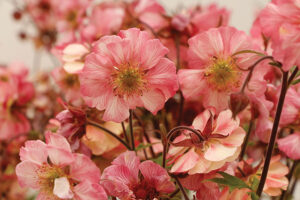
Culture Report: Geum Tempo series
Bearing the common name avens, the geum genus is experiencing a renewed interest from the gardening public. The moniker avens has a muddled origin with roots in Ireland, England and France. Its Medieval Latin name meant “a kind of clover.” Whatever one ends up calling geum, it is a sure bet that the likes of the Tempo series have not been seen before.
Terra Nova Nurseries took a critical look at what needed improvement in this genus and set out to give it a beneficial makeover. Not only were new flower colors achieved, but the careful breeding work also added weeks to the bloom period and fulfilled promises that other breeders couldn’t back up. Simply put: better flowers, better foliage and better habit. By introducing new species to the genetic mix, Terra Nova Nurseries achieved what hadn’t been done prior, namely greatly lengthened flowering period and the ability to rebloom again later in the year. Overall, geums are among the least fussy of all perennials, often surviving for a generation in gardens and developing woody stems like their rose bush cousins.

Geum ‘Tempo Orange’ is the plant that started Terra Nova on its quest to remake an old genus and breathe new life into a garden workhorse. The dense, mounded habit of this plant combined with short, branched flower stalks and excellent quality foliage stood out from its competitors — in a big way! Muted orange flowers shift to a soft peachy-taupe color and then drop petals neatly.

Terra Nova’s geum ‘Tempo Yellow’ came next in the lineup. Featuring large, semi-double primrose-yellow flowers, ‘Tempo Yellow’ mirrors ‘Tempo Orange’ nicely with the same excellent habit (especially for a yellow). With a high flower count and superior summertime foliage, there is no need to hide this beauty with summer annuals and no need to shear back plants because they are flagging and covering other plants. The flowers of ‘Tempo Yellow’ have a pleasing color shift from primrose-yellow to light peach and then to neutral champagne.

‘Tempo Rose’ is a gem. No other geum has this color flower that hovers over red-black stems for weeks on end. Flower buds emerge the color of a good rosé wine and progress onward to mid-pink and then pale pink. Perhaps the longest blooming of the series, ‘Tempo Rose’ is blessed with an outstanding habit — only slightly more upright than its siblings — and is stunning when planted en masse. In mixed containers, ‘Tempo Rose’ mixes brilliantly with purple, silver or black foliage.
PROPAGATION
Plants of the geum Tempo series are available as liners from tissue culture. Because they are genetically compact, they don’t produce good cuttings; thus, they are not available from cutting farms.
From the liner stage, maintain an optimal root zone temperature of 60 to 70° F. Begin feeding at 75 to 150 ppm nitrogen, maintaining an EC between 0.7 and 1.0. Avoid using ammoniacal type fertilizers, especially when young. These plants were bred for flower products and appreciate a fertilizer for flowering perennials. When planting a liner, always avoid burying the crown. This
can be fatal to a plant and geum suffer, notably when poorly planted.
FINISH TIMES
Geum finish relatively quickly, and the Tempo series are known to even flower as liners. Don’t worry, this won’t hurt the plant in the slightest. Remember, they’re bred for an extended bloom period.
MEDIA AND FERTILIZATION
Use care when selecting a soil for geum. Geum do especially well in an organic-based soilless media, especially composted barks with the addition of pumice. Avoid sodden soils. Allow plants to dry somewhat before rewatering. Geum make excellent greenhouse companions with heuchera, using similar soils and watering programs. Calcium nitrate-based fertilizers seem to be best for geum. Light-colored foliage can be an indication of high soil pH, or high EC, so monitor fertigation, as with any other crop. Sometimes magnesium sulfate in an aqueous solution is the answer to quickly deepen the foliage color of geum. This trick also works especially well on pulmonaria, too.
PINCHING AND GROWTH REGULATORS
Pinch a geum? Nope! And, these geum couldn’t be better behaved as both a container plant and a garden plant. Geum Tempo series are the end of the floppy-sloppy geums of old. PGRs are also not necessary. This plant holds well in liners, 4-inch and gallon pots without getting stressed.
PESTS AND DISEASES
Geum have few pests — really! In low humidity, high heat areas, spider mites can be a problem, but chances are one won’t have plants left to go through a high heat period. In the garden, sometimes slugs, snails or leaf cutter bees (after all, geum are in the rose family) might visit, but the fuzzy leaves deter most pests.
Powdery mildew is a rarity. Botrytis usually doesn’t show up unless the plants have gone through a period of a water stress event.
Overall, Tempo geum are among the easiest to grow new perennials in a long time.
For an enhanced reading experience, view this article in our digital edition by clicking here.









 Video Library
Video Library 


















